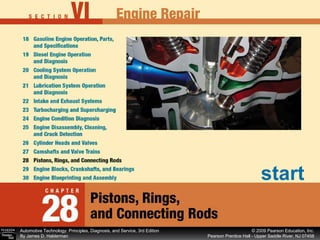
Chapter 28
- 1. start
- 10. CAUTION: Powdered metal connecting rods should only be marked with a permanent marker to avoid damage to the rod. Figure 28–3 Powdered metal connecting rods can be identified by their smooth appearance.
- 16. Figure 28–4 Piston head shapes: (a) flat (b) recessed, (c and d) pop- up, and (e and f) dished. (a) (b) (c) (d) (e) (f)
- 19. Figure 28–6 A piston diameter is measured across the thrust surfaces
- 24. Figure 28–10a & b Two sectional views of a slipper-skirt-type piston that uses a steel expansion strut. Continued
- 27. Figure 28–12 Grain flow lines can be seen in this forged aluminum piston with a trunk skirt.
- 29. Figure 28–13 Most piston pins are hollow to reduce weight and have a straight bore. Some pins have a tapered bore to reinforce the pin. Continued
- 37. Sometimes the piston pin can “walk” off the center of the piston and score the cylinder wall. This scoring is often not noticed because this type of wear does not create noise. Because the piston pin is below the piston rings, little combustion pressure is lost past the rings until the groove worn by the piston pin has worn the piston rings. Troubleshooting the exact cause of the increased oil consumption is difficult because the damage done to the oil control rings by the groove usually affects only one cylinder. Often, compression tests indicate good compression because the cylinder seals, especially at the top. More than one technician has been surprised to see the cylinder gouged by a piston pin when the cylinder head has been removed for service. In such a case, the cost of the engine repair immediately increases far beyond that of normal cylinder head service. Big Problem, No Noise
- 60. Figure 28–32 The connecting rod is the most highly stressed part of any engine because combustion pressure tries to compress it and piston inertia tries to pull it apart. Figure 28–33 Even though different rods may have different cross-sections, most are I-beam shaped.
- 74. Figure 28–44 (a) Flame-type connecting rod heater, the type most often used by remanufacturers because of the rapid heating. The rod should not be heated to more than 700°F (370°C). (If the rod turns blue, it is too hot.) (b) An operator removing the heated connecting rod and preparing to install it on the piston. Note the fixture used to hold the piston pin, and the dial indicator (gauge) used to ensure proper positioning. NOTE: The lock rings should always be replaced with new rings.
- 84. end